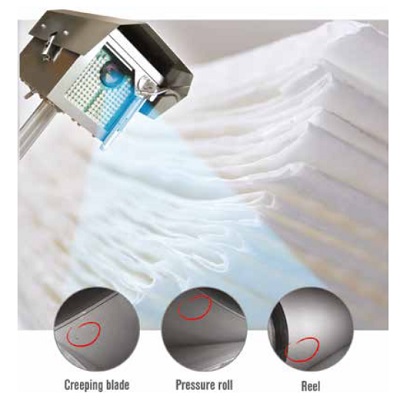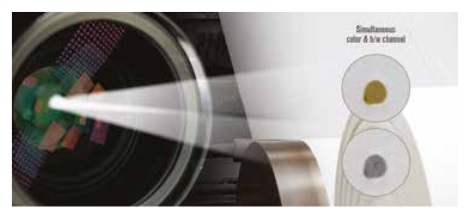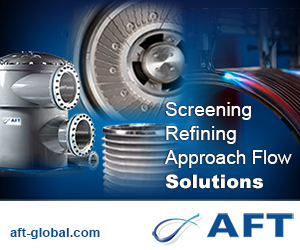Articles
PAPER MASTER - State-of-the-Art Technology along the Whole Process Chain

INTRODUCTION:
In today's paper, board, and tissue production, web breaks and a range of other substrate defects present a significant issue in all types of paper machines, coaters, and converting operations. Reducing breaks and paper defects is an important objective given the increasing speed and operating complexities of the present production environment.
ISRA is a leading provider of machine vision solutions supplying the pulp, paper, board, and tissue industry. A complete set of camera-based web monitoring and inspection systems covers the whole process chain from pulp to reel. In addition, our systems and software solutions help to optimize the entire production chain – from headbox to the ultimate delivery of the manufactured product to the customers.
This complete inspection setup enables manufacturers to significantly reduce costs caused by avoidable web breaks in the slitting and winding process, while accurate defect reports for each cut roll offer 100% production documentation. Typically, savings of 500.000 €/annum can be realized by implementing the complete inspection suite that consists of a Web Break Monitoring (WBM), Web Inspection System (WIS), Converting Control System (CCS), Unwind Control System (UCS), Paper Master Software and EPROMI Paper Quality Management.
In the next step, the Web Inspection System (WIS) captures high-resolution defect images over the full web width even at the highest web speeds with high-speed line cameras - or area cameras - and innovative lighting technology. For such a WIS systems, even though paper is mostly monochrome, the use of color cameras in the paper machine provides advantages. Such color cameras are not used (although this would be possible) to monitor the color of the paper but to find defects that are difficult or impossible to find with black-and-white cameras. Even more important is the use of color for classification, as this opens up new possibilities. Low contrast defects cannot be detected by black-and-white cameras and would most likely be missed. Moreover, the fault classification can be significantly improved due to the additional color information. It's now possible to distinguish between an oil and a water drop certainly an important feature for error source analysis.

Figure 1: State-of-the-art technology along the process chain – from Web Break Monitoring to Paper Quality Management.
Web Break Monitoring and Web Inspection are key to achieving optimized production results and quality
All installed components in a paper machine are exposed to harsh environments with dirt, moisture, and high temperatures in which optical-electronic devices operate very delicately. On top of that, a reduction in maintenance costs is always a welcome addition. To withstand these environmental conditions and minimize exposure, ISRA WBM System utilizes a special housing for the high-performance camera for web break analysis that always guarantees perfect image quality. Even the smallest details become visible with the camera so that faults can be automatically detected early in the development process and stopped in time before costly events occur. In addition to the high-resolution black-and-white camera with integrated analysis, an infrared camera completes the product range.

Figure 2: 100 % reliable web quality inspection driven by embedded color camera technology.
This analysis is further simplified and offers an even greater cost savings potential when the WIS is combined with the WBM. Then, a defect detection of the Inspection system is triggering the web break monitoring cameras alongside the machine back to the headbox. Following the defect through the entire production process reveals the position where it occurred and the defect origin.
Tissue: a different substrate, but (almost) the same process
To reduce web breaks and - once again - costs in the further processing of tissue products, the Converting Control System (CCS) detects surface defects logged by the inspection system on the Tissue machine. With double-width tissue machines, an additional middle-cut detection, inspecting the quality of the edges along the cut is done, and the production data is stored for later processing and retrieval.
During converting, several reels are combined and processed to form a multi-layer product. The converted jumbo-reels are not always complete reels. Several reels of different lengths per layer can be processed. Here, the CCS enables synchronization of the defect positions on the different layers; a layer merger has to combine defects from multiple reels into a multi-layer defect database first. The layer-independent defect position to control the speed of the converting line is then transmitted by the CCS. Thus, web breaks and equipment damage will be drastically reduced in tissue converting lines.
The speed in converting is automatically reduced whenever critical defects occur. This solution leads to significant cost savings due to avoidable reprocessing of the converting line after a web break, allowing for processing significantly more tissue and further increasing your yield.
Paper Master: Software makes the difference and connects the dots
A WBM or WIS cannot achieve the level of optimization without the software that connects all the bits and pieces of information gathered from sensors and cameras. PAPER MASTER 4.0 is the first browser-based platform for surface analysis to access the data of the ISRA system from anywhere, whether it be directly at the production line, in a meeting room, or on the road, by simply using mobile devices such as a tablet or a smartphone. PAPER MASTER 4.0 combines all data from the ISRA inspection and web break monitoring systems, the slitter and winder control, with all the software modules, in our paper quality management system on one browser-based platform. A new, modern, and intuitive user interface makes data access even easier.
PAPER MASTER 4.0 introduces a new dimension in the automated classification of defects and their assignment to defect classes and relieves the operator in the daily work while at the same time classification is secure.
The use of modern methods for artificial intelligence and deep learning reduces the optimization times of defect classification. The artificial intelligence methods, automatically assign the detected defects to individual classes. The usual, time-consuming, and error-prone training of the classifier by the operator is completely eliminated. It used to be common practice for the administrator or a trained operator to look at a very large number of defect images and manually assign them to different classifier classes. In the future, this lengthy process of manual classifier training will be carried out by AI algorithms - better and faster than humans can do.
System operators can now concentrate on their core tasks: The Production of Paper. The amount of data in the images evaluated by the algorithm is also significantly higher than with manual processing, increasing the classification accuracy.
It is important that hundreds of features are calculated for each defect recognized by the inspection system.
Thanks to these complex features, each defect can be described individually. This new, AI-based classifier is a step towards fully automated surface control. All this complex technology is hidden to the operator, running in parallel with the goal to make life easier for the user.
Make invisible data visible for predictive maintenance Another powerful software tool of Paper Master 4.0, EPROMI Live, enables you to easily and clearly monitor quality data of your surface and the manufacturing process. In addition, it offers information on the status of the systems in operation, the most important quality data, and the production performance.
This solution is able to highlight possible causes for emerging problems and prevent faults through targeted intervention – enabling predictive maintenance across the whole production process. In addition, EPROMI Live also supports dashboards that display and compare quality data from the ISRA inspection system with other data from the manufacturing process (such as speed, moisture, grammage, etc.).
From substrate product to final reel release Defects such as edge cracks and holes can lead to cost-intensive problems in downstream process steps, for example, breaks in the winder. By connecting the winder section with the inspection system installed on the paper machine, those defects are reliably detected during the winding process so that malfunctions in further processing will be prevented.
During the reel processing at the winder, the winder can access the corresponding stored defect database of this very reel using the ISRA Unwind Control System (UCS). The synchronization between the stored defect information with the position on the reel at the winder will lead to automatic speed adjustments whenever critical defects occur. This same solution can also be used to protect offline calenders and offline coating, or it could be used on rewinders stopping at a dedicated defect position to patch holes. To achieve an exact position synchronization between the defect database of the jumbo-reel from the paper machine and the current reel length on the winder, the application of a length code along the edge of the paper web has proven itself in practice. At the winder, a code reader unit will read this length code and synchronize it with the actual length of the defect database, regardless of how much material has been removed from the initial jumbo-reel.
To date, length codes have been applied with conventional inkjet marking systems that cause costs due to regular cleaning (once or twice a week), and high consumption of ink and water. In addition, possible ink contamination of the substrate can occur, leading to customer complaints as a consequence. ISRA's UCS LaserMarker overcomes these limitations by using an absolutely safe and reliable laser-based length code marking system with maintenance and consumables costs that are close to zero. In addition, distances between the individual length marks can be drastically reduced.
Where otherwise a mark was set every 1.000 to 2.000m, with laser-based marking units, a code distance of only 50m is typical. This leads to a higher precision of the synchronization. Moreover, laser-based marking systems are suitable for nearly any paper grade, from 10 grams upwards.
Thanks to the exact position synchronization on the winder, the Customer Roll Defect Report (CRDR) can be used to create individual roll reports with surface defect data for each individual roll. The CRDR places the current cutting plan over the synchronized defect database of the original jumbo reel. With knowledge of the exact knife positions and recording of the exact position of the web edge, a position-accurate defect report can be created for each roll. The role reports can then be used for further processing steps, or provide a prove-of-quality report to the customer if necessary.
With an additional software module, the Reel Release, an automated evaluation of each individual role can be conducted. Not only surface defect data is taken into account, but further process data from other sources, such as moisture, thickness, formation, etc., can also be included.
For each individual roll, an automatic quality assessment will be taken: whether the current quality meets the actual requirements, the roll needs to be sorted into a different quality level, or the paper needs to be repaired or returned to the production process through recycling. In doing so, it will save additional costs and contribute to the efficient use of valuable resources. Plus, it ensures that only quality approved paper is delivered to the customers.
Automatic surface inspection is a major building block for Industry 4.0
Optical inspection systems, available for all kinds of materials from board to tissue, can make a significant contribution to increasing profits and customer satisfaction. This is not limited to only a single paper machine but, with modern cloud solutions in a network, for an entire worldwide
production. The greatest savings potential can be realized from the reduction of the number of web breaks. Even a 20% reduction saves an enormous amount or increases the output of a paper machine.
About the Author:
Jorma Järvinen has spent over 30 years in the paper industry on almost all levels. He started his career as a laboratory assistant in a paper mill, followed by years working with suppliers to the paper industry as an application and service engineer. Järvinen then held various positions in sales leadership before taking over the position of Business Unit Manager for ISRA VISION's paper business in July 2021.








